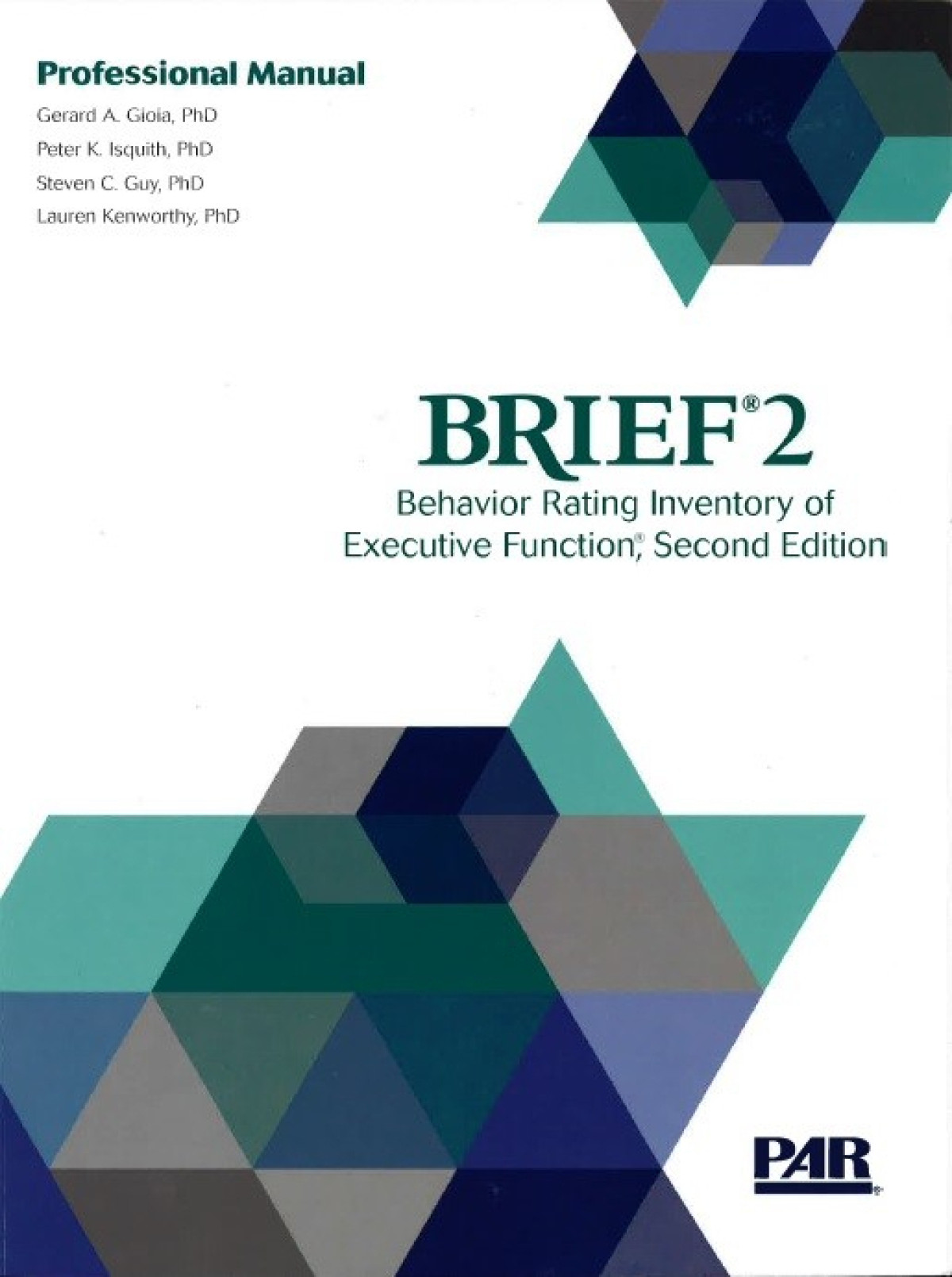
[PDF] Development of the Behavior Rating Inventory of Executive Function Preschool Version
The Behavior Rating Inventory of Executive Function ( BRIEF) is an assessment of executive function behaviors at home and at school for children and adolescents ages 5-18. It was originally developed by Gerard Gioia, Ph.D., Peter Isquith, Ph.D., Steven Guy, Ph.D., and Lauren Kenworthy, Ph.D.

Pin by Nabrim on Executive Functions Portfolio Executive functioning, Execution, Rating scale
Behavior Rating Inventory of Executive Function® Gerard A. Gioia, PhD, Peter K. Isquith, PhD, Steven C. Guy, PhD, and Lauren Kenworthy, PhD Purpose: Assesses impairment of executive function Format: Paper and pencil, Online administration and scoring via PARiConnect Age range: 5 years to 18 years Time: 10-15 minutes Qualification level: B DETAILS

Behavior rating inventory of executive functionadult version (BRIEFA)... Download Scientific
It is designed for a broad range of children for whom there may be concerns about self-regulation, such as those with autism spectrum disorder (ASD); learning disabilities (LD); attention disorders; traumatic brain injuries (TBI); depression; and other developmental, neurological, psychiatric, and medical conditions. What's Available
.png?author= Robert M. Roth, Peter K. Isquith, Gerard A. Gioia)
[PDF] Assessment of Executive Functioning Using the Behavior Rating Inventory of Executive
Abstract Objective In three studies, we explore the impact of response bias, symptom validity, and psychological factors on the self-report form of the Behavior Rating Inventory of Executive Function-Adult Version (BRIEF-A) and the relationship between self-reported executive functioning (EF) and objective performance. Method

Behavior Rating Inventory Of Executive Function cloudshareinfo
The Behavior Rating Inventory of Executive Function, Second Edition (BRIEF2; Gioia, Isquith, Guy, & Kenworthy, 2015 ), published by PARInc., is an updated individually administered rating scale of executive function (EF) for children and youth, aged 5 to 18 years.

(PDF) LongTerm Executive Function Deficits in Children With Traumatic Brain Injuries
Introduction Over 90% of children with acute lymphoblastic leukemia (ALL) will be long-term survivors [ 1 ]. Even after eliminating cranial radiation from most modern leukemia regimens, systemic and intrathecal chemotherapy continues to place pediatric patients at risk for neurocognitive impairment [ 2, 3 ].

Behavior Rating Inventory of Executive Function® (BRIEF®) Executive functioning, Metacognition
Skye McDonald References Roth, R. M., Isquith, P. K., & Gioia, G. A. (2005). BRIEF-A: Behavior Rating Inventory of Executive Function--adult Version: Professional Manual: Psychological Assessment Resources.

(PDF) TEST REVIEW behavior rating inventory of executive function
The Behavior Rating Inventory of Executive Function-2 (BRIEF2) was published in 2015 through Psychological Assessment Resources, Inc. (PAR). This is the first revision of the Behavior Rating Inventory of Executive Function (BRIEF) published in 2000 (Gioia et al. 2000).Like its predecessor, the BRIEF2 was designed to be completed by parents and teachers of school-aged children (5-18 years of.

(PDF) Behavior rating inventory of executive function
Captures executive functions in the everyday context providing an ecologically valid and efficient tool for screening, assessing, and monitoring current executive functioning and development. Intended as a focused measure of executive function and not as a broad measure of attention and behavior problems.

(BRIEF) Behavior Rating Inventory of Executive Function Executive functioning, Behavior, Execution
The Behavior Rating Inventory of Executive Function (BRIEF) was one of the first attempts to measure executive function via self- and informant reports of everyday functioning in the real-world environment and was the first published measure of these self-regulatory capabilities in children and adolescents (Gioia, Isquith, Guy & Kenworthy, 2000a).

BRIEF2 Behavior Rating Inventory of Executive Function®, Second Edition Hogrefe Psykologisk
(BRIEF) Behavior Rating Inventory of Executive Function by Gerard A. Gioia, PhD, Peter K. Isquith, PhD, et al Benefit Assesses executive function and self-regulation in children and teens Norms

[PDF] Behavior Rating Inventory of Executive FunctioningPreschool (BRIEFP) Applied to Teachers
The BRIEF is an 86-item parent-report questionnaire designed to measure executive functioning in children aged 5 to 18 years. 25 Parents rate if their child' s behavior is "never, " "sometimes.

(PDF) Behavior Rating Inventory of Executive Function™ BRIEF
DETAILS RESOURCES PRICING TEST TECHNICAL Useful in Assessing Adults for Attention Disorders, LD, ASD, TBI, Multiple Sclerosis, Depression, Cognitive Impairment, Dementia, and Schizophrenia The BRIEF-A is a standardized measure that captures views of an adult's executive functions or self-regulation in his or her everyday environment.

(PDF) Development of the behavior rating inventory of executive function (BRIEF) in five
The Behavior Rating Inventory of Executive Function (BRIEF) family of measures are rating scales completed by parents and teachers of school children aged 5-18 years (BRIEF), by parents and caregivers of preschool children aged 2-5 years (BRIEF-Preschool Version; BRIEF-P), by adolescents aged 11-18 years (BRIEF-Self-Report Version; BRIEF-SR), or.

BRIEF2 Behavior Rating Inventory of Executive Function, Second Edition (BRIEF2) Hogrefe
The Behavior Rating Inventory of Executive Function (BRIEF) family of measures are rating scales designed to facilitate assessment of the behavioral manifestations of executive dysfunction in everyday environments such as home, school, and work.

(PDF) Behavior Rating Inventory of Executive Function Preschool Version (BRIEFP) Test Review
The BRIEF2 is the second edition of the widely popular rating scale of executive function that continues to be as efficient, comprehensive, and consistent with current models as its predecessor. The assessment includes rating forms for teachers and parents (for ages 5-18), and a self-report form for children and adolescents (for ages 11-18).